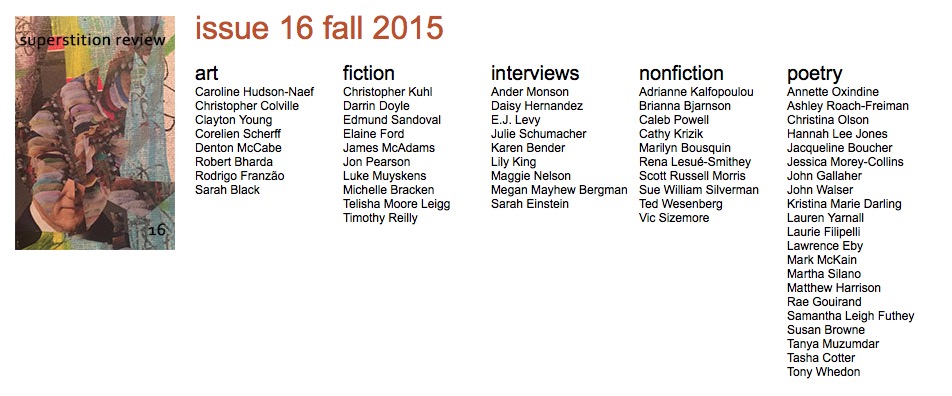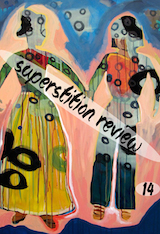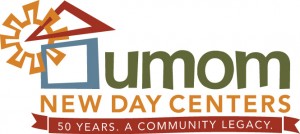
This morning at breakfast I did a little math. Those of you who know me understand that this is not good. Whenever I do math I get “math face.” Then I rifle through my purse for a calculator. Then I throw up my hands and quit.
But this morning I stuck with it, and here are some of the sums I managed: 13 Issues, 6.5 years, over 500 international artists and writers, 220 student editors, 822 blog posts, 5536 tweets. What an overwhelming privilege it has been to create this beautiful thing. And also to interact with talented people I admire; to meet with students and train them to read poems and html, to Tweet and to blog, to correspond with authors, to read other lit mags.
I’ve said before that my main goal with this magazine is to be a “literary ambassador.” I love that term, and I love that life, and I especially enjoy passing on that value to students. To that end, here is what we’ve done this semester:
1. We have published 60 artists/authors we admire in a beautiful format that is free.
2. We have shared literary news and ideas (and job ads!) across our social networks.
3. We have encouraged our community to subscribe to and read other literary magazines.
4. We have attended literary events in our town and at AWP in Seattle.
5. We have given back to our community in ways that enhance literacy and the arts. This year we did that three ways: a collaboration with the Creative Writing class at Combs High School, volunteering with Free Arts Arizona, and volunteering with UMOM’s Read to Me Program.
Putting together this issue was a true joy. I’ll comment on just a few things.
Art
Our cover is by New York painter Melinda Hackett. I solicited art from her after seeing her work on the cover of Post Road. I really enjoy her use of color and whimsical shapes. This issue features 10 artists from across the country and in a variety of media: from glass sculpture to photography to acrylics. I hope you enjoy viewing it as much as I do.
Events
Melissa Pritchard is our featured reader for this semester and I’m so pleased to have her. If anyone is a literary ambassador it is her! I admire her as a person as much as I admire her writing.
Fiction
This is our largest submission area, so we did a lot (I mean a lot) of reading. Sometimes in a reading period we’ll get 5 stories in a row narrated in past tense by a 25 year old male. It can be strange there in Submittable, as if someone spread the word that we want a particular type of piece. We don’t. We don’t run themes and we don’t even like to repeat much. The 10 pieces we chose represent what we felt was the best variety of topic, theme, and form. We tried to find a mix of traditional and experimental stories.
Interviews
We interviewed 10 authors ranging from Roxane Gay to Meg Wolitzer. Our interview process is perhaps the most intense of all the sections. Our two Interview Editors (always undergrads, usually English Lit Majors) carefully read and research each author, composing 20 mostly craft-based questions. Then we spend several weeks doing more research and revisions to the questions. I’m so grateful for all the work that these students do, and to the authors and poets who respond so thoughtfully.
Nonfiction
At AWP this year I got a lot of questions about our nonfiction section. We get the fewest number of submissions here, and I would say the highest number of submissions that miss the mark of our editorial preferences. So what is our aesthetic? I would call it lyric, non-linear, and as I said a few times to authors at the conference, “strange.” We like an essay to surprise and delight as much as a poem does.
Poetry
We get a ton of poetry submissions too, and since we take 4 poems per submission, we end up reading thousands of poems during a 10 week period. For this issue we published work by 20 poets, and as you’ll see there’s a wide variety of topic, theme, and form there.
So here are the well-deserved thanks (cue music): I can’t thank my Student Editors enough for their dedication. They spend many hours reading submissions, corresponding with authors, organizing content, and designing pages and advertisements. Oh, and Tweeting, Blogging, and Facebooking too!
Thanks also to my Faculty Advisors who contribute lots of time and energy to mentoring students.
And as always, deep thanks go to my Department Head Ian Moulton and Dean Duane Roen for their support.
Thanks also to our 60 contributors for this issue. I hope you enjoy the magazine.








